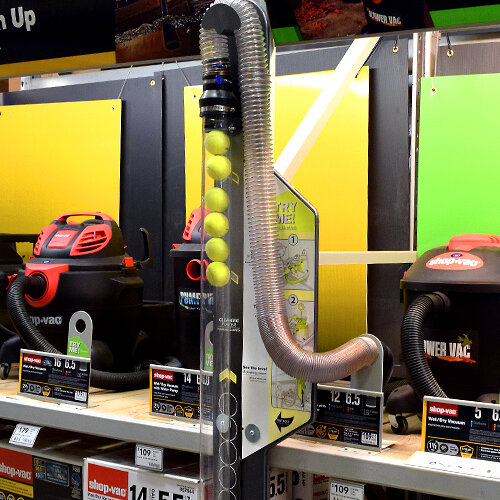Lowe’s
VACUUM TEST STATION
How do customers decide which product to purchase when they can’t try it first? In the case of shop vacuums, Lowe’s found this to be a real challenge for their customers. Presented with as many as a dozen options at their retail stores, customers were left to make purchasing decisions based on unrelatable statistics, such as horsepower, that do not even represent actual performance.
Lowe’s approached SPARK to help develop an in-store station which would allow customers to visually compare vacuum performance, so that they could make more informed selections and buy confidently.
“SPARK is very flexible to work with and could scale the work from R&D, to product testing, to competitive product tear-downs. They were able to integrate with the design team and supply relevant, and in some cases, game-changing solutions.”
— Abdul Koya
(Former Head of Engineering, Lowe’s)
THE GOAL
Over the past decade SPARK has provided periodic engineering and design support for Lowe’s internal design team on a wide array of projects. In this case, Lowe’s asked SPARK to tackle the early conceptual work on an in-store station that would allow customers to test vacuum options firsthand and compare performance head to head.
This experience would ideally be purely visual, so customers could immediately recognize the strengths and weaknesses of different models without any instructions or explanation. While this station would improve the customer experience, it was not directly correlated with sales, so the design also needed to be inexpensive and had to fit within the existing shelving of the retail store environment.
EARLY CONCEPTUALIZATION
Vacuum performance is a balance between vacuum and airflow. SPARK began by brainstorming methods for visually indicating balanced performance and approaches for customers to connect the display model vacuums to a centralized station.
Variations on lifting objects within a clear tube were quickly identified as the most cost effective, attention-grabbing, and accurate representation of performance. Early concepts considered using real-world materials such as wood chips or nails, but performance comparison between models was difficult unless the display was simple, fast-reacting, and visually obvious.
This experience would ideally be purely visual, so customers could immediately recognize the strengths and weaknesses of different models without any instructions or explanation.
JUST BUILD IT!
SPARK believes in physically testing our concepts early and often. Sketching is an excellent way to explore ideas fast, but interacting with real objects is an invaluable means for vetting ideas and pushing designs forward. Using a series of simple mock-ups SPARK was able to explore a range of concepts and quickly hone in on the most effective solution.
A variety of springs and bellows were tested, but the differences between vacuum models were less obvious, and without familiarity with the media inside the tube, customers wouldn’t get a sense of how much “work” the vacuum was actually doing.
FINAL DESIGN
Lifting stacks of billiard balls quickly proved to be a visually interesting option that customers could readily understand. However, the weight of falling billiard balls was too likely to damage the unit, so the final design made use of tennis balls to soften the impact, while still providing an impressive display of performance for customers.
Building on SPARK’s foundational work, Lowe’s was able to refine the design internally and ultimately installed vacuum stations in hundreds of locations nationwide. This success was representative of SPARK’s ability to solve unique problems and integrate our process within a larger design team to fill gaps in resources.










